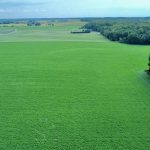Energy development is pushing at least one endangered bird to the brink.
The greater sage-grouse is already gone from about half of its historic range, an American researcher told the Prairie Conservation and Endangered Species conference in Regina.
The remaining population is located exactly where more development of gas fields in Montana and Wyoming is going to take place.
“They fit each other like a glove,” said University of Montana professor David Naugle of the habitat and gas fields. “This is where you see the perfect storm brewing.”
Read Also

Forecast leans toward cooling trend
July saw below average temperatures, August came in with near to slightly above average temperatures and September built on this warming trend with well above average temperatures for the month.
Greater sage-grouse are found in Alberta, Saskatchewan and 11 western states. Traditionally, the bird was also found in British Columbia and five more states.
There may have been 10 million birds before settlement. By 2001, population surveys found about 550 birds in Saskatchewan and 480 in Alberta.
The sage-grouse population was “already on its knees” before the development of 29,000 gas wells in the Powder River Basin along the Wyoming and Montana border, said Naugle. Permits could push the number of wells in the region to 66,000.
“The (bird) population trends are lower inside compared to outside of the gas fields,” Naugle said.
And, only one-third of the traditional spring breeding fields are still active inside the gas fields.
Naugle said the difficulty is deciding where to implement conservation efforts and at what cost.
“If you had to pick a smart wildlife species it wouldn’t be sage-grouse,” he said. “They’re very tied to the places they want to be.”
Reintroduction efforts have been successful only twice out of 52 times, he said, even when they were tried in traditional habitat.
One proposal looked at setting aside several protected areas. Last year a single fire wiped out about 30 percent of the sage brush in two of the proposed areas.
In a third, genetic isolation is a problem. And in another, the boundaries have been redrawn several times to avoid new gas wells.
Naugle said sage-grouse are highly susceptible to West Nile virus and that throws another card into the mix.
The first radio-marked bird confirmed dead from West Nile was found in 2003. By late that year, in four different populations, an average of 25 percent of the females had died.
“Local extirpations are very possible,” Naugle said.
Virtually all sage-grouse have been exposed to the virus, and he said the severity of future outbreaks will depend on mosquito populations, not resistance.
The ponds created for coalbed methane extraction have proven to be ideal breeding grounds for mosquitoes. Naugle said mosquito habitats have increased about 75 percent, and other researchers have found that culex tarsalis, the prime West Nile carrier, is more abundant in energy ponds than other water sources in the basin.
Naugle said because the federal government owns only 30 percent of the surface rights in the Powder River Basin, developing public policy to protect the sage-grouse is more difficult.
For example, who would pay for mosquito control in the coalbed methane ponds?
He also said that restoration after the gas plays out is possible but not a sure thing.
“We don’t have great examples of sage brush landscape restorations, let alone the critter,” he said.















